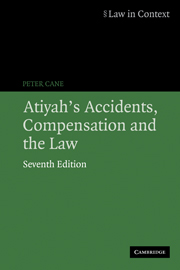Book contents
- Frontmatter
- Contents
- Preface
- List of abbreviations
- List of tables
- Table of legislation
- Table of cases
- Part One The Issues in Perspective
- Part Two The Tort System in Theory
- Part Three The Tort System in Operation
- Part Four Other Compensation Systems
- 11 First-party insurance
- 12 Compensation for criminal injuries
- 13 The social security system
- 14 Other forms of assistance
- Part Five The Overall Picture
- Part Six The Future
- Index
14 - Other forms of assistance
Published online by Cambridge University Press: 05 June 2012
- Frontmatter
- Contents
- Preface
- List of abbreviations
- List of tables
- Table of legislation
- Table of cases
- Part One The Issues in Perspective
- Part Two The Tort System in Theory
- Part Three The Tort System in Operation
- Part Four Other Compensation Systems
- 11 First-party insurance
- 12 Compensation for criminal injuries
- 13 The social security system
- 14 Other forms of assistance
- Part Five The Overall Picture
- Part Six The Future
- Index
Summary
So far we have considered the main sources of what might loosely be called ‘compensation’ for personal injury, and physical and mental disability; or, in other words, monetary payments designed to give financial support to the injured and sick on account of their disabilities. There are some other forms of assistance, not in the form of money payments, which also deserve to be considered briefly.
To provide some context for the discussion, we can note a recent estimate that there are 11 million disabled people1 aged 16 or over in Britain. Of these, 45% (compared with 15% of non-disabled people) are over State pension age (SPA). The majority of disabled people over SPA become disabled later in life. Amongst disabled people under 45, around 20% were disabled from birth and another 20% from childhood. Disabled people tend to be less qualified than non-disabled, and are more likely to be in skilled or unskilled, as opposed to professional, jobs. Overall, 44% of disabled people (as opposed to 79% of non-disabled people) are economically active. About a quarter of disabled people surveyed said they could work and expect to do so in the future. Only 13% of disabled working people have special working arrangements because of their disability.
The taxation system
The tax system as a whole is, of course, designed to raise revenue. But, by exempting some people from tax liability to which they would otherwise be liable, financial assistance of a negative sort can be provided to victims of accidents, disease and disability.
- Type
- Chapter
- Information
- Atiyah's Accidents, Compensation and the Law , pp. 363 - 374Publisher: Cambridge University PressPrint publication year: 2006

